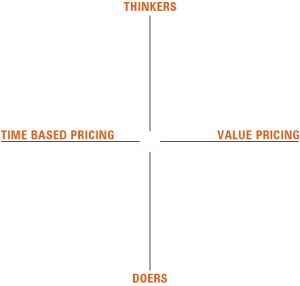Are you part of a rare breed of “creative” that cherishes those moments each day where you finally get to fill out your timesheets? While I’m sure you exist, most people in truth can’t stand it. So, if the general consensus is that we hate capturing time, then why do it at all? Why not save ourselves the grief and just ditch them altogether?
The goods news is that there are certain times (excuse the pun) that you can and probably should ditch timesheets. However, the reality is most creative firms are not set up in a way to throw away the stopwatch just yet.
So how do you decide whether or not your firm should be capturing time?
What type of firm are you and should you capture time?
I know all creative firms are uniquely different. You could be identified as a digital agency, a design studio, an advertising agency, a PR agency, or a branding agencies, to name a few. Or you could possibly provide some or all of these services and call yourself a “one stop shop”, an “integrated communication firm” or something elaborate (and creative) like “channel agnostic communication experts”.
But all of these firms have something in common. The services you provide your clients will ultimately be done by a “thinker” or a “doer” and the price for that service will be based on time or value. Depending on where your firm and the people within it sit on the map (below) will determine whether you should be capturing time or not.

Thinkers are the idea generators, the strategists, and the people who provide the solutions to their client’s problems.
Doers are the people that work on the tools and get stuff done. They are the project and account managers, the designers, the finished artists, and the producers.
Time Based Pricing firms sell their services based on units of time, (or at least calculate on that basis and then provide their client with a one-line estimate, giving themselves and their client the illusion that they are charging based on value).
Value Pricing firms sell their services based on the value they are ultimately providing to their clients.
Although their may be a few firms that can identify and sit neatly within one of the four quadrants above, it is more likely that you will sit across at least two of them.
Thinkers / Time-Based Pricing: If your firm prices your thinkers on a time-basis you need to capture and measure time.
An example of this could be a creative director who dabbles into the thinker/ value pricing quadrant when the right type of project comes in, but generally they sit here, overseeing, mentoring and providing guidance to the designers.
(Consider this: even if you are not ready to fully adopt a value based pricing strategy across your business, you should consider moving away from charging your “thinking” in units of time.
Thinkers / Value Pricing: If your firm or certain people in your firm sit (exclusively) in this quadrant they don’t need to capture time. If you charge a “concept fee” (thinkers/ value pricing method) and time-based pricing for production (doers/ time-based pricing) make sure you quarantine the value of concept fee from the rest of the project.
Doers / Time-Based Pricing: If your projects are estimate on an hourly basis, your designers, finished artists, producers, and account managers, etc. need to capture their time.
Doers/ Value Pricing: If you sit exclusively in this quadrant, it is likely that your business has evolved from time-based pricing to product based pricing. You have done so much of something over the years on a time basis that you have figured out an efficient way to deliver these “things” at a fixed and low price. E.g. $999 WordPress websites or $249 word templates. Timesheets in this quadrant are on a case by case basis. If you have only recently moved to product pricing, you may still need to capture time to confirm that your pricing is correct and profitable.
Before you decide to ditch timesheets in certain departments or across your business, consider the benefits that timesheet information provides.
Watch out for my next post on the importance of capture timesheets (for those who should)

